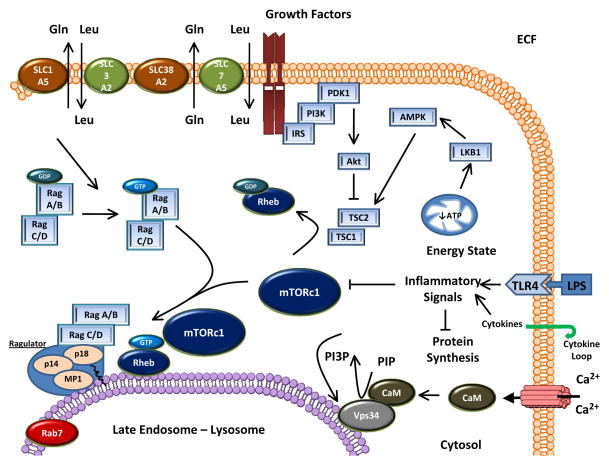Figure 2.
Activation of mTORC1 by nutrients (e.g., leucine) and growth factors (e.g., insulin and IGF-I). mTORC1 functions as the central regulatory hub of these anabolic inputs, but is also the site where various catabolic insults (e.g., inflammatory cytokines, excess glucocorticoids, hypoxia, and cellular energy stress) negatively impact mTOR kinase activity and protein synthesis in mammalian skeletal muscle. A key component of the activation of mTOR occurs when leucine is taken up by amino acid transporters (SLC3A2 and SLC7A5) in a heteroexchange for glutamine (SLC1A5 and SLC38A2)(5, 86). An increase in intracellular leucine activates Rag heterodimers to translocate mTOR to the lysosomal membrane where mTOR can be activated by Rheb in a “Ragulator” dependent process (19, 28, 107, 108). Amino acids may also signal to mTOR via the Ca+2/CaM dependent activation of the lysosomal membrane protein Vps34 (38). Negative regulation of mTOR is imposed by LPS and inflammatory cytokines that may impinge on upstream amino acid signaling and mTOR itself to prevent the phosphorylation of mTOR substrates and translation initiation as summarized in Table 2 and a recent review (63). Abbreviations used include ECF; extracellular fluid, LPS; lipopolysaccharide, TLR; Toll-like receptor, AMPK; AMP-dependent kinase, SLC; solute carrier proteins (amino acid transporters), Ragulator; complex of p14, p18, and MP1, Rheb; Ras homolog enriched in brain, PIP; phosphatidylinositol phosphate, PI3P; phosphatidylinositol 3-phosphate, Vps34; vacuolar protein sorting 34, CaM, calmodulin. Other abbreviations used in the figure are defined in the text.

